Pixar breaks the toon and tech molds once again with its 3-D Scottish princess adventure tale.
Move over, Cinderella: There’s a new princess in town, and she’s got more than a time-sensitive pumpkin to worry about. Meet Merida, the red-headed, bow-and-arrow-toting teen heroine of Disney-Pixar’s latest animated adventure, Brave, which brings the epic majesty of medieval Scotland in stunning 3-D CG animation to theater audiences this summer.
Set in the lush and wild Highlands of ancient times, Merida’s journey begins when her parents, Queen Elinor and King Fergus, declare that she must choose a lord’s son from one of three contentious clans for a husband. Free-spirited and preferring to bend her beloved bow than bend to her mother’s idea of the perfect princess, Merida makes an impulsive decision that threatens to throw her family and the entire kingdom into crisis.
Conceived by director Brenda Chapman (The Prince of Egypt) and inspired by her own relationship with her headstrong daughter, the film is also directed by Mark Andrews—who helmed the short One Man Band and served as story supervisor on The Incredibles and Ratatouille—and produced by Katherine Sarafian. The superb voice cast features Kelly Macdonald as Merida, Billy Connolly (King Fergus) and Emma Thompson (Queen Elinor) with Kevin McKidd, Craig Ferguson and Robbie Coltrane as the three feuding Lords and Julie Walters as an eccentric witch.
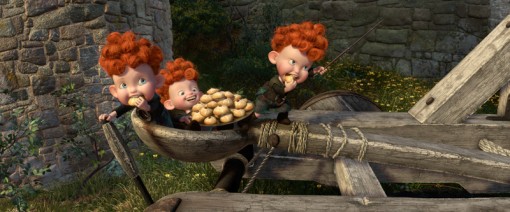
“Even though we have a female main character—she’s kind of Pixar’s first female main character—we’re not really going for the ‘princessy’ thing,” director Andrews shares during a brief interview at Pixar’s Emeryville, Calif. campus. “She’s a princess because that raises the stakes in the movie. Her being selfish is going to affect the whole kingdom, and that’s something that she has to deal with. If she was just a scullery maid, it wouldn’t be that interesting.”
The energetic helmer adds, amidst sound effects and expansive hand gestures, that he called on his own memories of teendom, relationships with his children and his wife’s (and seven sisters-in-law’s) experiences growing up and raising daughters to get inside Merida’s head. But in the end, he notes, the story is about a parent-child relationship and the trials of growing up—and that’s something to which anyone can relate, regardless of age or gender.
A Salute to Scotland
Part of what brought Andrews into Chapman’s project was their shared love of Scotland, a country whose rich heritage, fierce beauty and colorful people it was imperative to the Pixar team to recreate with due homage. Before he officially became involved, around September of 2010, Andrews served as the Brave crew’s go-to Scotland guy, and even helped organize a whirlwind research trip (one of two the team embarked on) to the country based on his own Scottish honeymoon tour.
For production designer Steve Pilcher, who joined the Brave team after a short stint designing garbage-laden sewers for WALL•E, the rustic settings of the film were a perfect outlet for his love of nature.
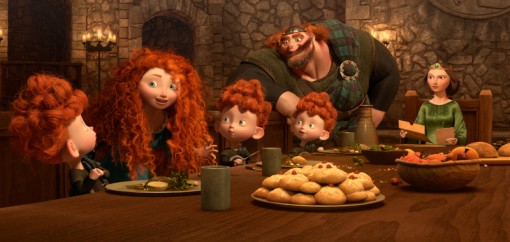
“I guess the biggest thing that drives me is the fact that nature is more powerful than anything, ever,” he shares. “It will always erode a castle or a road, and there’s something profound about that and I love to get that into anything that I’m doing.”
For Merida’s run-away adventure, nature figures prominently. Dense forests, grassy meadows and ancient stone formations sweep by as the story unravels, immersing the viewer in the sense of ancientness and magic that struck the Scotland travelers.
“The sets are like the best supporting actor or actress in the film,” Pilcher states emphatically. “They’re amazing characters. Even if they don’t speak, they speak spiritually.” He cites the visually implied personalities of the monoliths in the ring of stones, where Merida encounters the glowing blue will o’ the wisps of Scottish lore.
Incredibly, these rich environments were crafted by a very small team. Pilcher says he prefers to work with no more than five to seven multi-talented artists for as long as production pressures will allow. As the custodian of the design budget, Pilcher also had to be aware of the need to “design smart” within the realms of the studios (sizeable) technical capabilities.
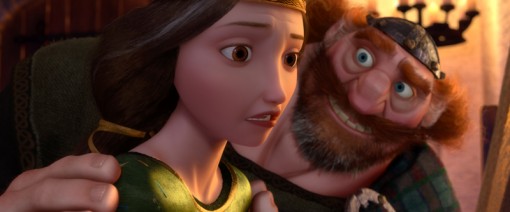
But that doesn’t mean all challenges were avoided. Because the natural world makes up the bulk of the sets, the filmmakers had to struggle with the physics of characters interacting with plush, springy mosses and tall meadow grasses. Call it nature’s wrath, CG animation style.
“That’s a very, very difficult thing and we’re still wrestling with that,” Pilcher admits. “In CG, when a character moves through grass it actually looks like a ghost moving through it; it penetrates and then materializes on the other side … You’ll find that in a lot of CG films they keep the grass really low, or put dirt there so nobody has to deal with that!” The production designer adds that a lot of hand finessing was required to make these sequences work, and that these interactions are becoming a good opportunity for more research.
Tresses, Dresses … and Kilts!
When trying to stand out against such lush landscaping, what in the world is a girl (or her medieval royal family, for that matter) to wear? Pixar overcame a host of CG impossibilities to realistically clothe the characters of Brave, control its heroine’s curly locks and imbue hair, fur and a variety of period-appropriate textiles with astounding realism.
One of the film’s crowning achievements is Merida’s thick, curly red hair. Add in the variety of waves, tight and loose curls and the wildness of it and Merida’s ‘do could be the subject of its own movie. As simulation supervisor Claudia Chung, who served in rendering and simulation TD roles for Incredibles and Ratatouille, explains, so much research went into understanding the physics of Merida’s hair that they ended up created a brand new simulation system to handle the unruly tresses.
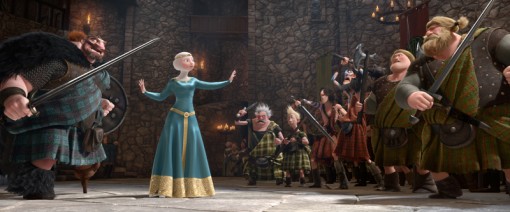
“One of the artists decided that curly hair is like a telephone cord you wave around,” she explains. “That’s the way Merida’s hair moves and that’s the basis of her model, but that’s according to a physics-minded researcher. That’s not natural-looking hair. The animation team wanted C-curves, S-curves—flowy hair that had nice follow-through when she turned her head. We finally figured out that Merida’s hair actually experiences a much lower gravity than the rest of the characters’.”
To build her mane, Chung and her team had to “grow” curves out of Merida’s model’s “scalp.” Color-coded to denote hue and the tightness of the curl, 1,500 individual curves were artfully hand-placed over a period of six months (and you thought your cut and dye job took forever!), which in turn generated approximately 111,700 hairs. Constructing the princess’ five different hairstyles and figuring out how her massive mop would interact with other materials (as when she removes her hood during the pivotal archery contest scene; a sequence that spent two months in simulation) added to the sizable challenges.
These were necessary challenges, as Andrews points out.
“When Brenda [Chapman] was designing the characters, she started with this essence of conflict between the mother and daughter. Deciding the mother was a queen and what it is to be a queen in this medieval world. She needed to be a strong person. So, she has the long hair, but it’s kept in the perfect braid … Who’s her daughter going to be if there’s a conflict? … She’s gonna have wild, crazy hair. She’s kind of a troublemaker, a fire-starter, so we make it red. It’s all visual design that goes into giving audiences a hint as to who the character is going to be.”
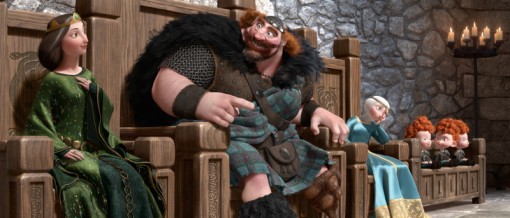
While all the film’s costumes require special attention—from hand painting silk to inspire Elinor’s gown to designing unique Tartans for each clan—King Fergus proved to be the largest costuming challenge. As a warrior-king, Fergus needed layers of chainmail, armor, a folded kilt and even a bear-fur cloak—eight layers in total. And, each layer needed to move according to its material’s physics and interact with the other layers.
“A lot of it is really just geeking out about how chainmail moves, how leather moves, how that’s different from how a Tartan moves,” she explains. “We have all this material as reference in our offices and we’re constantly bending them, pulling them, stressing them.”
Information about a material’s stretchiness, the thickness of its fold and the grain of the fabric are then fed into the simulator.
The traditional Scottish kilt proved one of the most difficult articles to simulate. Since it is one long length of fabric that drapes across the body and is then folded repeatedly into a pleated skirt, the team struggled with how to control the movement of these different shapes. Chung’s team tested a variety of techniques, from tailoring flat patterns to model builds, but in the end arrived a hybrid approach.
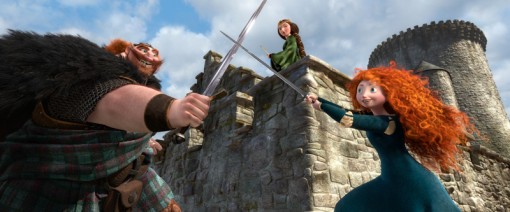
“The tailor who designed Fergus came up with the idea [for the kilt’s skirt] that he basically created an accordion, a zig-zag pattern of the mesh, and then when it relaxes with the simulator it becomes a folded kilt.” This also allowed for the tension of character movement, allowing the fabric to “unfold” rather than warping and stretching. “We do have cheats in there. Between each layer we have a light ‘glue’ or springs that are holding it together so it doesn’t completely unwind … One of the challenges when you have skirts and kilts is making sure that the character is always decently covered!”
Another inspired breakthrough helped lend a realistic weight and texture to fabric never before achievable. The “digital weaving” technology created by Philip Child allowed for modeling individual threads with irregularities in thickness and color that the computer then wove together into cloth. “It really helped with our simulation because as the character would stretch or bend an elbow, the weaves actually separate. The individual thread is not warping or doing some weird thing, you actually see holes through the cloth.” It was used for the wool of Merida’s dress, the Tartan kilts and anywhere possible, according to Chung.
While advances in CG simulation technology have opened up new avenues for animators, Chung acknowledges there is still a little push-pull when it comes to techies and tooners working together toward a common goal. An example of this is found in Angus, Merida’s beloved Clydesdale horse who, along with presenting plenty of hair simulation effort (think mane, tail, fetlocks and all-over fur) caused a bit of head butting to find a compromise between realistic physics and graphic appeal when it came to his tail.
“When you look at a horse’s tail in 2D animation, it’s super graphic. It’s essentially a paintbrush shape … but a real horse’s tail is nothing like that. It explodes, it’s totally crazy, it moves all the time,” Chung elaborates. “We would ping-pong back and forth between that graphic look and this totally ballistic, dynamic look. The problem we realized in simulation is that if we made that perfect drop shape, then it didn’t look real in the environment of Brave, because Brave is more realistic when it comes to dynamics.” The simulation team solved the problem by maintaining the ballistic movement of the hairs, but restricting it to inside a silhouette of the graphic shape the animators wanted. “We were looking at animation from Beauty and the Beast and thinking, ‘Oh, look how they did the tail on that, how did they make that look so good?’ Well, they got to draw it! Which is way easier!” she laughs.
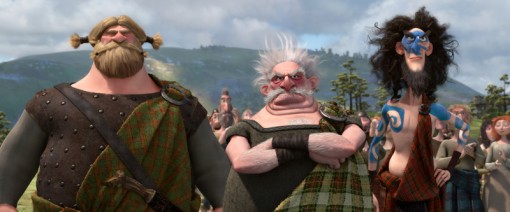
Crafting a New Legend
Despite their varied responsibilities, what holds the Brave teams and Pixar’s creative pool together is the mantra, “Story comes first.” Each decision from the type of tree in a scene to the color of a princess’ hair goes toward further clarifying the story. And it was in pursuit of an exceptional story that the Pixar heads brought in Andrews for a mid-game assist, to fine-tune Chapman’s vision; whatever the rumor mill might say.
In addition to his many passions applicable to the project (Scotland, medieval history, archery and yes, his very own kilt), Andrews was a natural match because he had been closely involved with Chapman and the development team, watching reels alongside John Lasseter, Andrew Stanton and Ed Catmull as part of the studio’s Brain Trust.
“They had most of the assets built, all the characters were designed, animation tests had been done. It’s almost the same play that had been done with Ratatouille,” the director recalls. “But it always comes down to story. Is the story playing? We knew we were going to come out summer of 2012 and that the story has to be fantastic … and they needed to make a change.”
Andrews, who comes from a story department background, says bringing in someone who has an outside perspective and is able to be merciless with the film can be a huge benefit to a production. As it stood the basic elements of Brave like the mother-daughter relationship and Highland setting were strong.
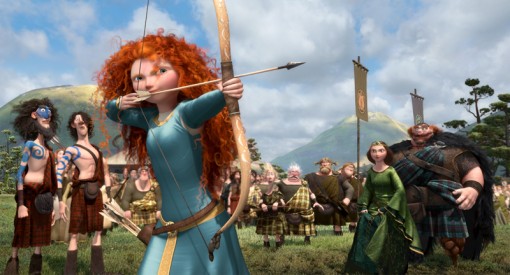
“It wasn’t like, come in and start from scratch and let’s put it in Oregon during the Gold Rush,” he quips.
And even though some good material was eventually dropped, many of these cuts lead to similar, better ideas that furthered the story—such as a bit with Merida’s triplet brothers and the comical Lords that evolved into a castle-wide goose chase, taking full advantage of the impressive indoor sets. He also encouraged putting more animals into the film due to its wild settings.
Of course, you do sometimes have to be the bad guy.
“I know that the tech guys doing the snow were very unhappy with me,” he says with a wry grin. “We cut out the second half of the film that took pace in the snow, because of a magic spell.” He did make some amends however, with a snowy alternate opening that he says will appear on the Blu-ray release.
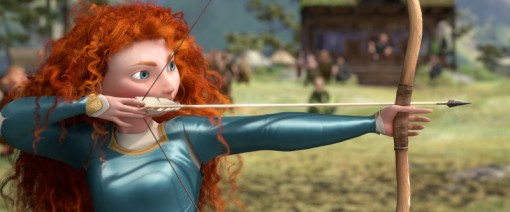
Despite the reshaping of the film’s story arc, and the improbability of finding such things in ancient Scotland, Pilcher assures us that the Pixar tradition of inserting special Easter Eggs into its films held fast. But the Pizza Planet truck hidden away in a medieval castle or clump of Scots Pines?
“When you see it, you’ll laugh. It’s right in front of your face,” he confirms. “I’m not going to say what it is but let’s just say it fits into the world perfectly…in some ways we’ll customize it a bit to make sure it feels the same, but yeah, they’re all in there. And a few extras!”
In addition to a gleeful moment of inside joke camaraderie, what Andrews hopes that audiences—especially kids—take away from the film is that they can be as brave as its heroine:
“[Bravery] isn’t this type of thing where you fight monsters, or run into battle courageously. It’s about looking at yourself. The world is a scary place, especially for a kid on the edge of being an adult—being a teenager is the scariest place there is! To be brave, to figure out the difference between what you wanted to be and what the world wants you to be, that truth lies within you—if you’re brave enough to look inside yourself.”
Disney-Pixar’s Brave takes aim at theaters June 22, paired with Enrico Casarosa’s Oscar-nominated short, La Luna.
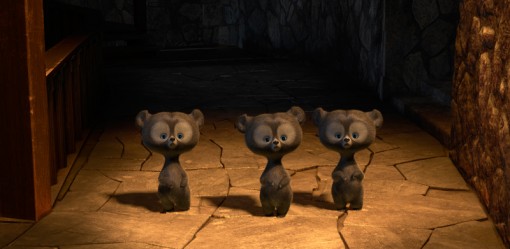
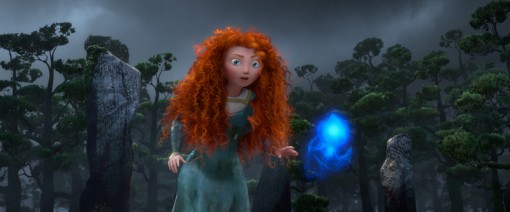
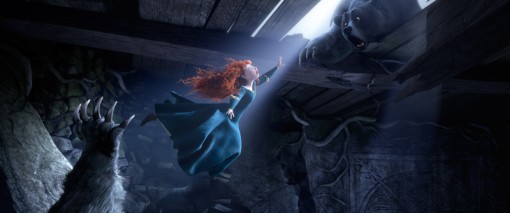
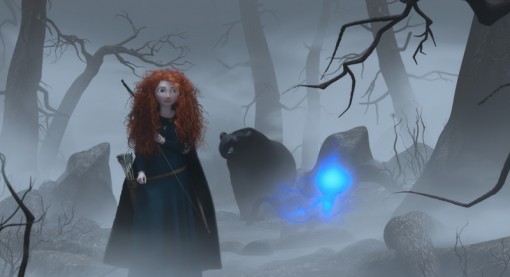
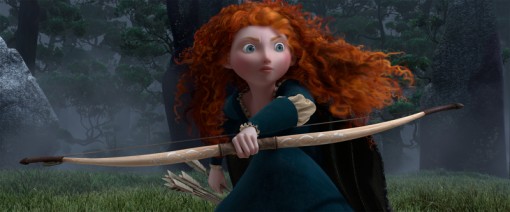
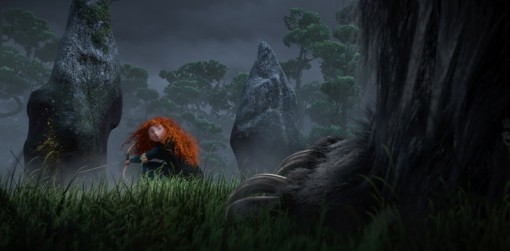
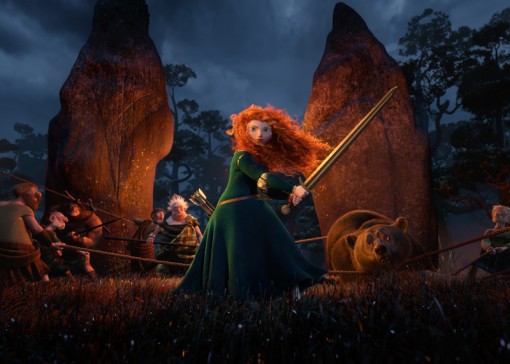







I for one would have preferred to see Chapman’s vision come to life, whether it plays or not in the collective mind of the so-called “Brain Trust.” Let’s not forget, this Brain Trust has kept Pixar from having strong female characters up to this point. And it green-lit Cars 2.
Pixar is caught in the blockbuster trap: It is stuck in the pattern of spending and making hundreds of millions on every film and can’t afford to take real risks. But I think it should. If Pixar made four films with four new directors for 25 million each and loosened up on the stranglehold that has already claimed a few of its directors-to-be, I bet the audiences, and the stockholders, would be pleasantly surprised.